The National Parks in Washington DC are the home to some of the oldest protected parklands in America, the National Mall, and Memorial Parks contain a number of America's most emblematic landmarks. Stretching from the U.S. Capitol to the Washington Monument the National Mall is the perfect place to stroll while reflecting on American history.
Other notable monuments include the Jefferson, Lincoln, and Vietnam Veteran's Memorials. Plan on several days for this mega-attraction.
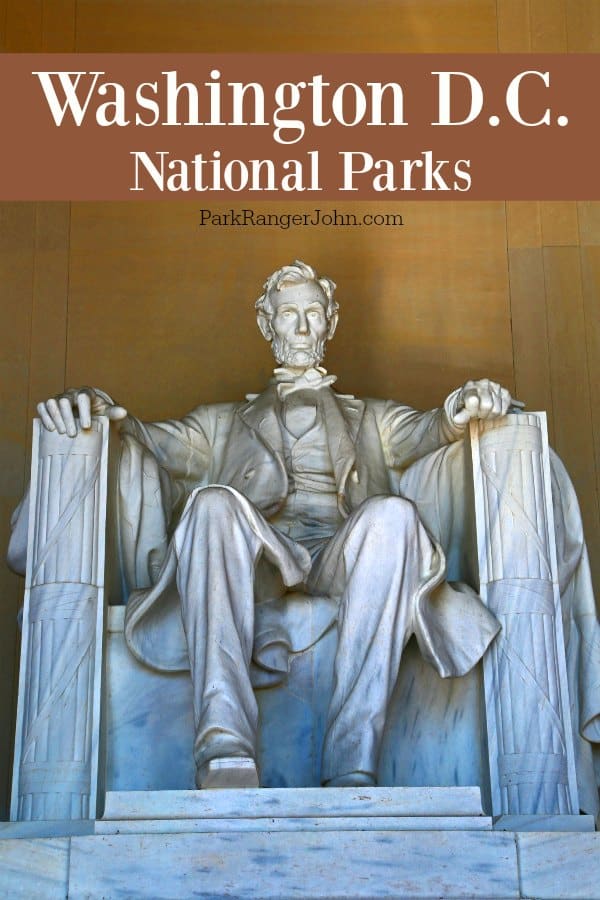
National Parks in Washington DC
The White House is just one of our national icons in Washington, D.C. Plan carefully to see as many as your time allows. Every American should see our beautiful capital. Springtime, when the Japanese cherry trees are in full bloom, maybe the prettiest time to go, but it will also be one of the busiest.
Many of the monuments are all within walking distance. They form a big cross in the center of D.C.
The apex is the Washington Monument. It is the great obelisk, a tall white pointy statue. Construction was stopped for 30 years due to a lack of funds and the Civil War. You can see a color change where the work was resumed.
It was erected to honor our first president and Revolutionary War leader George Washington.
Tours of the White House must be arranged in advance by one of your state representatives. It will take one to six months, so plan in advance to make this the highlight of your trip.
Opposite the White House is the Jefferson Memorial. Thomas Jefferson was our third president and the main author of the Declaration of Independence.
Reading some of his works at his memorial reveals the remarkable beliefs our country was built upon. The view from the White House must inspire our presidents.
If you don't have a vehicle, take a short taxi ride or Uber over to the Jefferson Memorial, as there is no direct access, only a busy bridge around the Tidal Basin.
The Metro is the cheapest transportation around the city. It is very nice and clean. If you pack light, you can even take it to and from the airports.
Another reasonable way to view all the sites is to take the hop-on, hop-off City Sightseeing bus. If you only have 2 days and want to see the most sites, this is a great option.
At the top of the cross is the Lincoln Memorial. The solemn statue of Honest Abe is quite impressive. Take some time to reflect, our country 's history and heroes, sitting on the staircase looking over the Reflecting Pool, Washington Monument and on to the Capitol.
You can also tour the Capitol by prearranged tickets available on the website or through your state representative.
The National Mall is the area between the Lincoln Memorial and the Capitol. It is filled with many statues, memorials, and museums. The most impressive are the World War II Memorial, the Smithsonian's, and the United States Holocaust Memorial Museum.
Most museums' entry is free. You could spend weeks here and not see them all. Most of the museums have cafeterias for starving tourists. If possible, wait till after 1:30 p.m. when the rush slows.
Every trip to Washington, D.C., should also include a trip to Arlington National Cemetery. 250,000 Americans, who died in service of the United States, are buried there. Open October to March from 8 a.m.-5 p.m. with on-the-hour changing of the guard at the Tomb of the Unknown Soldier. During the spring and summer, the hours are 8 a.m.-7 p.m. with guards changing on the hour and half hour.
Washington, DC offers enough national monuments to keep a family, couple or individual busy and interested for as long as a vacation lasts.
National Mall and Memorial Parks
There are 25 National Parks in Washington DC that are managed by the National Park Service. Check out the Washington DC: Monuments and Memorials Segway Tour for a fun way to see many of the main sites.
Belmont-Paul Women’s Equality National Monument
Top Things to do - Explore the House and Museum, Take a Guided Tour, Participate in Educational activities,
Lodging - There are no lodging options within the park
Camping - There are no campgrounds within the park
Park Address - 144 Constitution Ave NE, Washington, DC 20002
Belmont Paul Women's Equality National Monument is located on Capitol Hill in Washington D.C. President Barack Obama designated the national monument on April 12, 2016.
It is hard to believe that Belmont Paul Women's Equality National Monument was one of the least visited National Park Sites in 2018! I would love to see this change and have a ton more visitors to learn more about this important site.
Home to the National Woman's Party for nearly 90 years, this was the epicenter of the struggle for women's rights.
Carter G. Woodson Home National Historic Site
Top Things to do - Tour The Woodson Home, Learn about Dr. Woodson’s Life and Legacy
Lodging - There are no National Park lodges within the site
Camping - There are no campgrounds within the park
Park Address - 1538 Ninth Street NW, Washington, DC 20001
Dr. Carter G. Woodson’s home served as the headquarters for the Association for the Study of African American Life and History. Dr. Woodson established Negro History Week here in 1926, which we celebrate today as Black History Month.
Rangers offer guided interpretive tours of the house on Thursdays, Fridays, and Saturdays. The tours last for 45 minutes. Reservations are recommended.
Chesapeake and Ohio Canal National Historical Park
Top Things to do - Biking, Boating, Camping, Canal Boat Program, Fishing, Hiking, Horseback, Riding, Picnicking, Ranger-Led Programs, Winter Activities
Lodging - The C&O Canal Trust's Canal Quarters program offers several lodging options in lock houses along the canal.
Camping - The park offers two different types of campsites: Primitive Campsites for hikers and bikers, and Reservable Campgrounds for individuals and groups. There are no RV hookups in the park.
Park Address - 142 W. Potomac St., Williamsport, MD 21795
Chesapeake and Ohio Canal NHP is located along the Potomac River from Washington D.C. to Cumberland, Maryland. The park offers hiking, biking, boating, camping, and outdoor recreation.
In 1828 the Chesapeake and Ohio Canal construction was started. Over the next 22 years 35,000 workers many of them immigrants from Ireland and Western Europe dug the canal and built aqueducts, culverts, and locks.
The first five boats filled with coal traveled the length of the canal in October 1850. At the peak of operation, the canal saw more than 540 boats in service with most of them carrying coal.
Visitors today can see 184.5 miles of the old canal right of way from Georgetown neighborhood in Washington D.C. to Cumberland, Maryland. The towpath has been restored so you can see the path where mules pulled boats.
Constitution Gardens
Top Things to do - Join the Guided Tour, Explore the Gardens, Visit Lincoln Memorial
Lodging - There are no National Park lodges within the park.
Camping - There are no campgrounds in the park
Park Address - 1850 Constitution Ave. NW, Washington 20002
Constitution Gardens is located on the National Mall between the Washington Monument and Lincoln Memorial. The park is open year-round with a viewing memorial to the signers of the Declaration of Independence.
The park was created as a tribute to the American Revolution and its 200-year old legacy. The artificial lake was built within the park in 1984. On July 2nd, a memorial was dedicated located on the small island within the lake. The memorial consists of 56 stones with the names of the signers of the Declaration of Independence engraved on them.
Dwight D. Eisenhower Memorial
Things to Do - Look at the tribute statues, tapestry, and inscriptions
Lodging - There is no lodging within the park
Camping - There are no campgrounds within the park
The park includes bronze sculptures, stone bas reliefs, and inscriptions of Eisenhower's famous speeches and addresses.
Ford’s Theatre National Historic Site
Top Things to do - Join a Ranger Program, Attend One Destiny, Tour Ford's Theatre Museum, Rent an Acoustiguide, Take a walking tour, Visit the Petersen House, Explore the Aftermath Exhibits
Lodging - There are no lodging options within the park
Camping - There are no campgrounds within the park
Park Address - 511 10th Street NW, Washington, DC 20004
Ford's Theater NHS is located in Northwest D.C. The park is open year-round and offers tours of the theater and museum along with the Peterson House.
On April 14, 1864, Abraham Lincoln and his wife Mary attended a play at Ford's Theater located six blocks from the White House. This was just days after Confederate General Robert E. Lee had surrendered at Appomattox Courthouse. They were looking to enjoy a night out and escape the pressures of the post Civil War period.
Unfortunately, President Lincoln was shot by John Wilkes Booth who was a Confederate sympathizer and actor. President Lincoln was moved across the street to the house of William Peterson where he passed away on the morning of April 15, 1865.
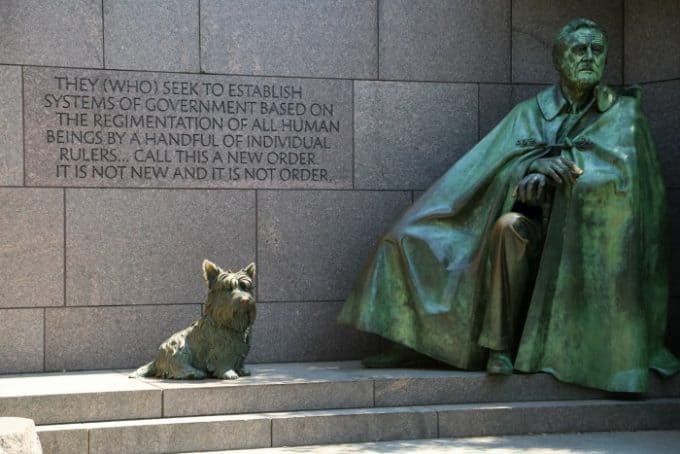
Franklin D. Roosevelt Memorial
Top Things to do - Learn about FDR's Legacy, Explore the Memorial, Join a Guided Tour
Lodging - There are no National Park Lodges in Washington DC.
Camping - There are no campgrounds within the park
Park Address - 400 West Basin Drive SW, Washington 20002
The Franklin D. Roosevelt Memorial is located in West Potomac Park near the Jefferson Memorial. The park is open year-round and is free to explore.
Franklin D. Roosevelt was elected president in 1932 during the Great Depression. He was re-elected three times before passing away in office in 1945. He is the only U.S. President to serve more than two terms.
The Franklin Delano Roosevelt Memorial is 7-acres dedicated to FDR. There are four open-air galleries, one for each of his terms. The waterfalls and water features reflect the importance of water in FDR's life. He served as assistant secretary of the Navy during World War I and also oversaw the dam-building projects of the Tennessee Valley Authority.
There are also sculptures of FDR with his beloved Scottish Terrier, Fala along with a sculpture of Eleanor Roosevelt standing in front of the seal of the United Nations.
Frederick Douglass National Historic Site
Top Things to do - Take a Ranger Led Guided Tour, Visit and watch a film at the Visitor Center, Junior Ranger Program, Join the Annual Oratorical Contest
Lodging - There are several choices available in the Washington, D.C. area.
Camping - The site does not offer camping.
Park Address - 1411 W Street SE, Washington, DC 20020
Frederik Douglass NHS is located in the Anacostia neighborhood of Washington D.C. The park is open year-round and offers tours of Frederick Douglass's home and grounds.
Frederik Douglass was born in 1818. Despite being born into slavery he learned to read without any formal education. He escaped to the free North and became an internationally known and respected author and speaker.
He was dedicated to the abolitionist movement and equal rights for African Americans. He was also a newspaper publisher and served in many government positions including US Minister to Haiti and U.S. Marshal for the District of Columbia.
In 1877 Frederik Douglass purchased a 9-acre estate that he named Cedar Hill. He would live in this house until he passed away in 1895.
Today you can take a ranger-led guided tour of Cedar Hill. Reservations are recommended. You can visit recreation.gov or call 1-877-444-6777 to book your tickets.
George Washington Memorial Parkway
Top Things to do - Hiking, Biking, Wildlife Watching, Play ball, Join a Ranger Led Program
Lodging - There are no National Park lodges within the parkway.
Camping - There is no camping available on the parkway.
George Washington Memorial Parkway was designated a park and playground in the 1930s. There are quite a few sites along the parkway as it leaves Washington D.C. to visit and explore.
Information, brochures, maps, and National Park Passport stamps are available at parkway headquarters and at visitor centers at Arlington House, Glen Echo Park, and Great Falls Park.
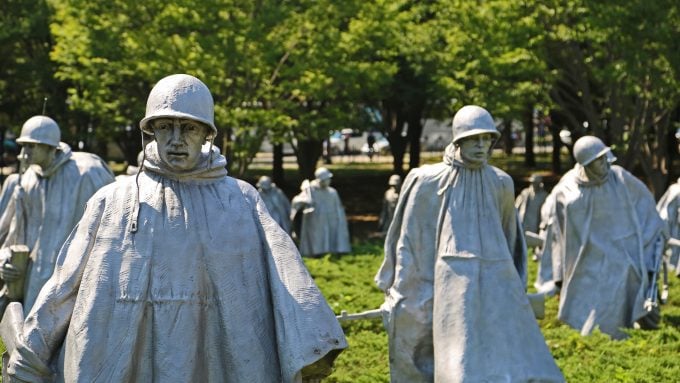
Korean War Veterans Memorial
Top Things to do - Explore the Memorial, See the 19 Stainless Steel Statues of Soldiers, The Pool Of Remembrance
Lodging - There are no National Park lodges within the park.
Camping - There are no National Park Campgrounds near the memorial.
Park Address - 10 Daniel French Dr, SW Washington 20002
The Korean War Veterans Memorial is located on the National Mall near the Lincoln Memorial. The park is open year-round.
The Korean War Veterans Memorial was dedicated in 1995 to honor the American men and women who served during the Korean conflict. The Korean Conflict was never declared a war. It is often considered the forgotten war.
The memorial includes nineteen realistic stainless steel statues that depict members of the Army, Navy, Marine Corps, and air force dressed to reflect the harsh Korean climate. There is also a polished granite wall that reflects the troops.
Lincoln Memorial
Top Things to do - Guided Tours, Junior Ranger Program, Enjoy a breathtaking view of the National Mall, Walk up the steps of the Memorial and enter the Main Chamber,
Lodging - There are no lodging options within the Lincoln Memorial.
Camping - There is no camping within the park.
Park Address - 2 Lincoln Memorial Circle, NW Washington 20002
The Lincoln Memorial is located at the West end of the National Mall overlooking the Potomac River. The park is open year-round.
Abraham Lincoln was the 16th President of the United States. He served during the Civil War, emancipated enslaved people in the South and was assassinated days after the end of the Civil War in 1865.
The Lincoln Memorial was dedicated in 1922 and takes it architectural inspiration from Greek temples. The memorial was built using materials from different parts of the United States.
Lyndon Baines Johnson Memorial Grove on the Potomac
Top Things to do - Ranger-led Programs, Bicycling, Canoeing or Kayaking, Hiking, Picnicking, Wildlife Viewing, Walking or Running
Lodging - There are hotels in Washington, D.C., or Arlington, Virginia, as well as private rentals or accommodations in neighboring communities.
Camping - There are no campgrounds within Lyndon Baines Johnson Memorial Grove
Park Address - Lyndon Baines Johnson Memorial Grove, Washington DC
The Lyndon Baines Johnson Memorial Grove on the Potomac is located off the George Washington Memorial Parkway. The park is open year-round and offers walking and biking trails.
The heart of the Lyndon B. Johnson Memorial Grove is a 43-ton 19-foot monolith made of red Texas Granite. The memorial was created to remember LBJ's love for the land in his native Texas.
There are hundreds of dogwoods, azaleas, and rhododendrons around the memorial. You can enjoy picnic tables, winding paths, and markers inscribed with LBJ quotes. The Lyndon B. Johnson Memorial is located within Lady Bird Johnson Park which was renamed in 1968.
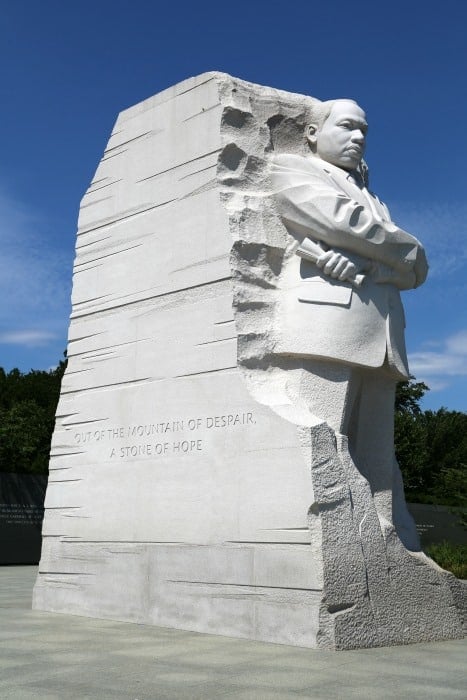
Martin Luther King, Jr. Memorial
Top Things to do - Join Ranger Programs, Guided Tours, Be a Junior Ranger
Lodging -There are no lodging options within the park.
Camping - There are no camping opportunities within the park.
Park Address - 1850 West Basin Drive SW, Washington DC
The Martin Luther King Jr. Memorial is located in the National Mall. The park is open year-round.
The MLK Jr. Memorial was dedicated in 2011 near the spot where Martin Luther King Jr. gave his famous "I Have a Dream" speech during the 1963 March on Washington for Jobs and Freedom.
The memorial is a granite sculpture created by Chinese artist Master Lei Yixin. The memorial depicts Martin Luther King Jr. as a "stone of hope" emerging from a "mountain of despair".
These words were taken from this "I have a dream" speech. The memorial includes a 30-foot tall figure of Martin Luther King Jr. with his arms crossed looking hopeful towards the horizon.
There is also a wall inscribed with quotes from Martin Luther King Jr.'s speeches.
Check out the African American History Tour & African American History & Culture Museum tour.
Mary McLeod Bethune Council House National Historic Site
Top Things to do - Become a Junior Ranger, Guided Tours, Self-Guided Tours - Walking, Learn about the life and achievements of Mary McLeod Bethune
Lodging - There are no lodging options available on-site. However, there are several lodging options in the surrounding area of Washington, D.C. that you can consider. Some nearby neighborhoods with lodging options include Downtown, Dupont Circle, and Foggy Bottom.
Camping - There are no campgrounds within the park.
Park Address - 1318 Vermont Avenue NW, Washington, DC 20005
Mary McLeod Bethune Council House NHS is located in Northwest Washington D.C. The park is open year-round and offers tours of the historic home and a park movie.
Mary Mcleod Bethune was born in 1875 to parents who had been enslaved prior to Emancipation. She was very focused on her education. She became one of the most influential African Americans in the mid 20th century.
Mary McLeod Bethune truly believed that education was incredibly important to the empowerment of African-American women. She started a school in 1904 in Daytona Beach, Florida that was for poor black girls. This school grew to become Bethune-Cookman University.
Mary McLeod Bethune served as president of the university prior to being appointed the director of the Office of Negro Affairs of the National Youth Administration by President Franklin D. Roosevelt.
This position made her the first African-American woman to head a federal agency. Starting in 1935, She worked to create the National Council of Negro Women (NCNW). The NCNW brought together more than two dozen organizations to work for better education and employment opportunities for African-American Women.
The group acquired a headquarters in 1943 which is where Mary McLeod Bethune lived until 1949. Today you can take a guided tour of the house and view a film talking about Mary McLeod Bethune's life and work. Rangers guide interpretive tours of the house on Thursdays, Fridays, and Saturdays
National Capital Parks
Top Things to do - Camping, Spring and Fall Campfire programs, Front-Country Hiking, Junior Ranger Program
Lodging - Nationals Park is located in Southeast Washington, south of the Capitol, along the fast-developing Capitol Riverfront adjacent to the Navy Yard. There are a variety of lodging options available within easy walking distance.
Camping - Greenbelt Park offers 172 campground sites with showers/ bathroom facilities within 10 miles of the Nation's Capital.
Park Address - 1900 Anacostia Drive SE
National Capital Parks-East is 13 park sites, parkways, and statuary covering more than 8,000 acres of historic, cultural, and recreational parklands from Capitol Hill to the nearby Maryland suburbs.
National Capital Parks includes:
Anacostia Park
Top Things to do - Roller Skating, Hiking the Anacostia Riverwalk Trail, Picnicking, Wildlife Watching, Boating, Visit the Aquatic Resources Education Center and Kenilworth Aquatic Gardens
Lodging - There are no lodging facilities within the park itself. However, there are several lodging options available in neighboring communities or nearby areas in Washington, D.C.
Camping - There are no campgrounds within the park.
Park Address - 1900 Anacostia Drive, S.E. Washington, DC 20020
Anacostia Park is a neighborhood national park located in Washington, D.C. Managed by the U.S. National Park Service, it offers a range of recreational activities and has become an important natural and cultural resource in the city.
The park's history dates back to the early 20th century when construction began in 1923. It was developed by the Office of Public Buildings and Grounds (OPBG), with the completion of dredging and construction of the cultural landscape in 1924.
Anacostia Park gained historical significance during the "Bonus March" in 1932 when World War I veterans set up a campsite in the park, demanding early payment of their bonuses. This event had a profound impact on the nation and led to the passage of the G.I. Bill.
Today, Anacostia Park offers various recreational activities. It features the popular Anacostia Riverwalk Trail, a 3.5-mile paved trail along the Anacostia River, ideal for walking, jogging, and biking. The park also provides facilities for roller skating, fitness stations, picnicking, grilling, and playgrounds for children.
Anacostia Park is home to the Kenilworth Aquatic Gardens, the only aquatic garden in the National Park Service. Visitors can explore beautiful water gardens and enjoy the serene atmosphere.
The park is supported by the nonprofit organization Friends of Anacostia Park, which works to preserve the land, enhance the visitor experience, and create green spaces within the park.
Anacostia Park serves as a recreational hub, offering opportunities for outdoor activities, relaxation, and appreciation of the natural beauty of the Anacostia River. It is a cherished space for both locals and visitors to enjoy and connect with nature in the heart of Washington, D.C.
Baltimore-Washington Parkway
Top Things to do - Enjoy a picnic or camp in Greenbelt Park, Visit the NASA Visitor Center, Visit the National Wildlife Visitor Center, Doctors Hospital
Lodging - There are no lodging options within the parkway
Camping - There are several camping options near the Baltimore-Washington Parkway.
Park Address - 6565 Greenbelt Road, Greenbelt, MD 20770.
The Baltimore-Washington Parkway is a 29-mile highway that connects Baltimore, Maryland, and Washington, D.C. It has been a popular route for travelers since it opened in 1954. The parkway was established by Congress through Public Law 81-643 on August 3, 1950.
While the Baltimore-Washington Parkway provides a direct route between Baltimore and Washington, D.C., some individuals suggest using alternate routes like I-95, which is located a few miles to the west, to avoid potential traffic congestion.
The Baltimore-Washington Parkway serves as a scenic and convenient transportation route between Baltimore and Washington, D.C. It has a significant history and cultural importance, but it is important to stay informed about current road conditions and consider alternate routes when necessary.
Capitol Hill Parks
Top Things to do - Enjoy a picnic on the Capitol Grounds, Visit Eastern Market, and Explore Lincoln Park
Lodging - There are no National Park lodges within the park
Camping - There are no campgrounds within the park
Park Address - Capitol Hill Parks are spread out in various locations on Capitol Hill
Washington, DC 20003
The Capitol Hill Parks constitute a cluster of urban green spaces situated to the east of the U.S. Capitol in Washington, D.C., overseen by the National Park Service. Among the notable areas within this network are:
- Folger Park, named in honor of Charles J. Folger, a former Secretary of the Treasury.
- Lincoln Park, the largest unit spanning 7 acres, dedicated to the sixteenth president, Abraham Lincoln.
- Stanton Park, was named after Edwin Stanton, Lincoln's Secretary of War.
- Marion Park, paying homage to Francis Marion, a leader in the Revolutionary War.
Additionally, the Capitol Hill Parks encompass the Eastern Market and Potomac Avenue Metro stations, along with various smaller land parcels such as Seward Square, Twining Square, the Maryland Avenue Triangles, the Pennsylvania Avenue Medians, and 59 inner-city triangles and squares. These spaces serve as recreational havens for local residents and the broader public, contributing to the diverse portfolio of parkland and historic sites managed by National Capital Parks-East.
Civil War Defenses of Washington - Fort Circle Parks
Top Things to do - Guided Tours, Hiking, Biking, Join the annual commemoration of the Battle of Fort Stevens, Wildlife Viewing
Lodging - While there are no lodging options within the Fort Circle Parks themselves, there are several accommodation options available nearby.
Camping - There are no camping options within the park
Park Address - Civil War Defenses of Washington
6625 Georgia Ave N.W. Washington 20012
The Civil War Defenses of Washington were a ring of fortifications to protect the city from invasion by the Confederate Army. Now wherever you are in the city, one of these parks is nearby! Start exploring on your own by researching the forts, or join a ranger program for an immersive tour.
Fort parks are not only places that tell a national story; they also play valuable ecological roles in an urbanizing landscape. Like the other parks of the National Park Service, they are home to wildlife and native plants and host a variety of valuable natural resources.
Fort Dupont Park
Top Things to do - Hiking, Join the Fort Dupont Event Series, Reserve a plot at Fort Dupont Community Gardens
Lodging - There are no lodging options within the park
Camping - No campgrounds are available at the park
Park Address - 3600 F Street SE Washington, DC 20019
Fort Dupont Park and the surrounding Civil War Defenses of Washington sites along the Hiker / Biker Trail consist of more than 400 acres of mature wooded forest, 10 miles of paved and unpaved trails, picnic sites, an activity center, a community garden, and a concert stage.
This 361 acre wooded park was once home to an earthen fort built to protect Washington, DC, during the Civil War. Today, visitors can see the fort's earthworks and escape to the great outdoors. Activities include picnics, nature walks, biking, gardening, environmental education, music, and ranger-led programs.
Fort Foote Park
Top Things to do - Explore the park, Enjoy the breathtaking view of the Potomac, Visit Nearby Attractions
Lodging - There are no lodging options within the park
Camping - No campgrounds are available at the park
Park Address - 8915 Fort Foote Road, Oxon Hill, MD 20745
Fort Foote Park is a neighborhood gem in southern Maryland that offers opportunities to ponder history and connect with the beauty of the Potomac River.
The park is home to two Civil War Rodman cannons and remnants of the earthwork fortifications. It's a neat little park off the beaten path and a little difficult to find at first. It's cool to see the big guns they used to protect the fort partially being swallowed back up by nature.
Explore the wonders of Fort Foote Park and all that it has to offer. Take a step back in time as you stroll the grounds that once roared with the sound of gunfire.
Fort Washington Park
Top Things to do - Fishing, Birdwatching, Civil War Artillery Demonstrations, Wildlife Watching, Hiking, Picnicking
Lodging - Fort Washington Park itself does not have lodging options within the park grounds. Visitors typically stay in nearby towns or cities and commute to the park. The closest major city is Washington, D.C., which offers a wide range of lodging options. Some nearby towns with accommodation choices may include Fort Washington, Oxon Hill, and National Harbor.
Camping - Greenbelt Park is located approximately 20 miles north of Fort Washington. The campground offers tent and RV camping in a wooded setting.
Park Address - 13551 Fort Washington Road, Fort Washington, MD 20744
Built to defend the river approach to Washington, DC, Fort Washington has stood as silent sentry for over 200 years. As technologies advanced so did Fort Washington, from the brick and stone of the 19th century to the concrete and steel of the 20th century. Joining the National Park Service in 1946, the park continues to protect the Potomac River.
Fort Washington Park has a wide variety of activities. There is a 3-mile trail that follows the perimeter of the park boundary, offering the opportunity for wildlife viewing. Birdwatchers enjoy the quite solitude of the park to find that one special bird. If fishing is for you, the park is located right along the Potomac River where there are many different types of fish waiting for you.
One Sunday a month from April to October the park has Civil War artillery demonstrations.
Greenbelt Park
Top Things to do - Camping, Hiking, Picnicking, Junior Ranger Program, Have fun at the Playground
Lodging - There are no National Park lodges within the park
Camping - Greenbelt Park offers 172 campground sites with showers/ bathroom facilities within 10 miles of the Nation's Capital. Reservations required
Park Address - 6565 Greenbelt Road, Greenbelt, MD 20770
Greenbelt Park is located in suburban Greenbelt, Maryland just ten miles from the Washington D.C. attractions.
Visit to enjoy affordable camping, peaceful surroundings in an urban forest, and National Park Service hospitality. Greenbelt Park has a 172 site campground, nine miles of trails and three picnic areas.
Greenbelt Park is a hidden jewel located just outside of Washington, DC. It provides a sylvan escape from the busy city life where you can camp, hike, and enjoy time with friends and family.
Harmony Hall
Top Things to do - Walking trail to historic Want Water and Broad Creek, See the Harmony Mansionm, the Restored Slave Quarters, Enjoy the garden and the scenic view of the Potomac River, Visit Harmony Hall Arts Center, Birdwatching
Lodging - There are no lodging options within the park
Camping - There are no campgrounds at Harmony Hall
Park Address - 10702 Livingston Rd. Fort Washington, MD 20744
The 18th century Harmony Hall mansion is located on a 62.5-acre open pasture land estate along the Potomac River. This estate was purchased by the National Park Service in 1966, to preserve southern Maryland cultural heritage. Surrounded by a rich landscape, it offers visitors many chances to connect with Colonial History. The park also home to the remains of the Want Water House and canal.
Harmony Hall has one of the oldest structures in Prince Georges County within its boundaries...Want Water.
Harmony Hall Mansion is currently closed to the public. However the public is welcome to explore the grounds. Use the information you find here to discover what Harmony Hall has to offer.
Kenilworth Park & Aquatic Gardens
Top Things to do - Ranger Tours, Birding, Hiking, Biking, Explore the beautiful garden, Join Lotus and Water Lily Festival
Lodging - There are no National Park lodges within the park
Camping - There are no camping options within the park
Park Address - 1550 Anacostia Ave. NE Washington, DC 20019
Deep within Kenilworth lies an oasis, hidden behind trees and cattails. It's a place where beavers build their homes and turtles sleep on logs. Lotus blooms rise from the muck and lilies sit on the water. The wind dances with the dragonflies, rustling through the trees, carrying the song of the birds until it brushes across your face, fading to a whisper, saying "come join."
Open every day except January 1, Thanksgiving, and December 25, Kenilworth Aquatic Gardens welcomes visitors from near and far.
10,000 years before any colonists arrived in what is now known as the Anacostia River there was a thriving Native American culture. The Nacotchtanks used this land to its fullest, using plants like cattails for food, medicine, and shelter. What is now known as Kenilworth Aquatic Gardens is eventually bought by Walter Shaw who turns what was considered unusable farmland into an aquatic garden. Later his daughter Helen Fowler expands the business, bringing in even more important flowers until it eventually becomes the National Park you see today.
Langston Golf Course
Top Things to do - Enjoy a game of golf at the historic 18-hole, Picnicking
Lodging - There are no lodging options within Langston Golf Course. However, there are several lodging options available in the surrounding area.
Camping - There are no campgrounds available within Langston Golf Course
Park Address - 2556 Benning Rd NE, Washington, DC 20002
Under the shadow of segregation, the Langston Golf Course was built to service the nearby African American community in 1939. It was one of twenty golf courses in America that was open to African Americans; whites had 680 to choose from. Washington, DC, was the birthplace of the first men's and women's African American golf clubs: the Riverside Golf Club (1924), now the Royal Golf Club, and the Wake Robin Golf Club, originally comprised of the wives of Riverside members who were tired of being left at home alone all weekend.
Oxon Cove Park/Oxon Hill Farm
Top Things to do - Hiking, Biking, Exploring the Plantation Home, Wildlife Viewing, Birdwatching, Enjoy the gardens and domestic animals.
Lodging - There are no lodging options within the park
Camping - There are no camping opportunities within the park
Park Address - 1967 Bald Eagle Road, Oxon Hill, MD 20745
The diverse history of Maryland and our national heritage can be experienced at Oxon Cove Park. Through hands-on programs and other activities, you can experience farm life and how its changed over time. Explore how the park evolved from a plantation home during the War of 1812, to a hospital farm, to the park you can visit today.
Oxon Cove Park provides an escape from the bustling city. Visitors can enjoy a wide variety of activities. Whether you’re interested in farm animals and gardens, nature and wildlife, history and culture, or exercise like jogging, hiking, and biking, you’ll find something to love at Oxon Cove Park.
Piscataway Park
Top Things to do - Birdwatching, Fishing, Boating, Hiking, Visit the National Colonial Farm
Lodging - There are no National Park lodges within the park
Camping - There are no campgrounds within Piscataway Park
Park Address - 3400 Bryan Point Road, Accokeek , MD 20607
Piscataway Park is home to bald eagles, beavers, deer, foxes, ospreys, and many other species. To complement the surroundings, the park has, in addition to a public fishing pier and two boardwalks over freshwater tidal wetlands, a variety of nature trails, meadows, and woodland areas. The Park is also home to National Colonial Farm.
The boardwalk and living shoreline at Accokeek Creek are just a few of the things to discover in Piscataway Park.
Piscataway Park offers many opportunities for exploration and recreation. Whether you are looking for birdwatching spots or great views of Mount Vernon, begin here to plan a memorable visit
Potomac Heritage Trail
Top Things to do - Hiking, Wildlife Viewing, Birdwatching, Biking, Thru-Hiking, Explore History, Picnicking
Lodging - There are no lodging options within the trail
Camping - There are no designated campgrounds within the trail
Park Address - Potomac Heritage National Scenic Trail c/o Chesapeake and Ohio Canal National Historical Park 142 W. Potomac St. Williamsport, MD 21795
The Potomac Heritage National Scenic Trail has something for everyone. History, nature, recreation, wildlife, and conservation are all themes that find a home within the Trail network.
Sewall Belmont House and Museum
Top Things to do - Ranger-Led Programs, Exhibits and Guided Tours
Lodging - There are no National Park lodges within the park
Camping - There are no campgrounds within Sewall Belmont House and Museum
Park Address - 144 Constitution Ave NE Washington, DC 20002
The Sewall Belmont House and Museum, now known as the Belmont-Paul Women's Equality National Monument
The museum is a historic house and a symbol of the U.S. women's suffrage and equal rights movements. It's one of the oldest houses on Capitol Hill and the headquarters of the historic National Woman's Party. The museum has unparalleled archives and a collection of fine art and artifacts from the woman's suffrage and equal rights movements.
Located on Capitol Hill in Washington, D.C., the home is a short walk from Union Station.
Home to the National Woman's Party for more than 90 years, this was the epicenter of the struggle for women's rights. From this house in the shadow of the U.S. Capitol and Supreme Court, Alice Paul and the NWP developed innovative strategies and tactics to advocate for the Equal Rights Amendment and equality for women. President Barack Obama designated the national monument on April 12, 2016.
Belmont-Paul Women's Equality National Monument is free and open to the public on Friday through Sunday from 10:00 AM until 5:00 PM.
Ranger-led tours of the exhibits are offered at 10:00 AM and 2:00 PM. No reservations are required.
Shepherd Parkway
Top Things to do - Hiking, Picnicking, Enjoy Nature, Wildlife Viewing
Lodging - There are no National Park lodges within the parkway
Camping - There are camping options within Sheperd Parkway
Park Address - 1900 Anacostia Drive SE Washington 20020
Shepherd Parkway is part of the Civil War Defenses of Washington. It includes two civil war sites: Fort Greble and Fort Carroll. Today visitors can still see remains of both earthwork fortifications.
On April 11, 1927 the National Capital Parks and Planning Commission acquired what is today Shepherd Parkway to connect the rest of the civil war forts in the Nation's capital for purposes of a parkway called "Fort Drive". While that idea was never realized the park became part of the National Park Service in 1933 and is today a mature wooded forest with a rolling terrace gravel terrain that offers a home to a variety of wildlife.
National Mall
Top Things to do - Hiking, Fishing, Ranger Guided tours, and Special Events
Lodging - There are no lodging options within the park
Camping - There are no campgrounds within the National Mall
The National Mall stretches two miles from the steps of the Capitol to the Lincoln Memorial. The National Mall encompasses the original mall, Washington Monument Grounds, the Tidal Basin area, and West Potomac River behind the Lincoln Memorial.
There are more than 26 miles of pedestrian sidewalks and 8 miles of trails for biking within the National Mall. Some of the most famous museums in the United States line the original Mall including the National Air and Space Museum, National Museum of Natural History and the National Museum of the American Indian.
Pennsylvania Avenue
Top Things to do - Visit The Old Post Office Tower, Willard Hotel, Washington DC, US Navy Memorial, Temperance Fountain, Stephenson Memorial (Grand Army of the Republic), Major General Winfield Scott Hancock Monument
Lodging - There are National PArlk lodges within Pennsylvania Avenue
Camping - There are no campgrounds within Pennsylvania Avenue
Park Address - 1 Pennsylvania Ave, NW, Washington 20002
Pennsylvania Avenue runs between the U.S. Capitol and the White House. This unique site preserves locations related to the creation of the Federal City, Presidential Inaugurations, and historically significant events.
Presidents Park - White House
Top Things to do - Tour the White House, Visit the White House Visitor Center, Explore the President’s Park, and Attend Special Events like the White House Garden Tour. National Christmas Tree Lighting, Become a Junior Ranger
Lodging - There are several hotels available in the vicinity.
Camping - There are no camping options within the White House
Park Address - 1450 Pennsylvania Ave., NW, Washington 20230
The White House also is known as President's Park is located at 1600 Pennsylvania Avenue.
President's Park includes open spaces, monuments, statues, and buildings around the White House as well as the White House itself.
Tours of the White House are by advance reservation only and must be made through your Member of Congress. Requests can be submitted up to three months in advance and no less than 21 days in advance.
If you wish to visit the White House and are a citizen of a foreign country, please contact your embassy in Washington, DC, for assistance in submitting your request.
The White House Visitor Center is located at 1450 Pennsylvania Ave. The visitor center includes 100 historical artifacts, interpretive panels, an interactive touchscreen tour of the White House, over 90 artifacts from the White House collection and the park film.
Rock Creek Park
Top Things to do - Have a Picnic, Join a Ranger-led Program, Visit the Planetarium, visit the Center Exhibit Hall, Go for a Hike, Ride a Bike, Go Fishing, Play Gold or Tennis, Go Paddling
Lodging - There are several lodging options in Washington DC
Camping - There are no campgrounds within Rock Creek Park
Park Address - 5200 Glover Rd, NW, Washington, DC 20015
Rock Creek Park is the green space along Rock Creek from the Potomac River to the Maryland state line. The park is open year-round and offers hiking, biking, bird-watching, horseback riding, and more.
In 1890, legislation was created to protect Rock Creek Park. The park was set apart as a public park for the benefit and enjoyment of the people of the United States. The park is one of the oldest federal parks in the country.
It stretches for more than 10-miles from the Potomac River along Rock Creek to the boundary line between Washington DC and Maryland.
The nature center's planetarium is the only planetarium in the National Park Service. Theodore Roosevelt used to visit the park to go bird-watching.
Theodore Roosevelt Island
Top Things to do - Ranger-led Programs, Island Tours of Theodore Roosevelt Island, Wildlife Viewing, Walking or Running, Canoeing or Kayaking,
Lodging - Virginia has many hotels and other lodging options.
Camping - There is no camping in the park.
Park Address - George Washington Memorial Parkway northbound lanes between Roosevelt Bridge and Key Bridge, Arlington 22209
Theodore Roosevelt Island is located in the Potomac River off of the George Washington Memorial Parkway. The park is open year-round and offers hiking and a statue of Roosevelt.
Theodore Roosevelt was the 26th President of the United States. Many consider him to be the conservation-minded President. He protected/created so many sites including Devils Tower, Muir Woods, and the Grand Canyon.
He also established the Us Forest Service and set aside more than 230 million acres of land for national parks, forests, monuments, and wildlife refuges.
Thomas Jefferson Memorial
Top Things to do - Appreciate the Architectural details of the Memorial, Participate in a Ranger Program, Enjoy the Views
Lodging - There are no National Park lodges within the memorial
Camping - There are no camping within Thomas Jefferson Memorial
Park Address - 16 East Basin Drive, SW, Washington 200024
Thomas Jefferson Memorial is located on the National Mall at the Tidal Basin. The park is open year-round and offers a view of a statue of Thomas Jefferson and marble panels with quotes from Thomas Jefferson.
Thomas Jefferson was the third President of the United States, chief author of the Declaration of Independence and the force behind the Louisiana Purchase and the Lewis and Clark Expedition.
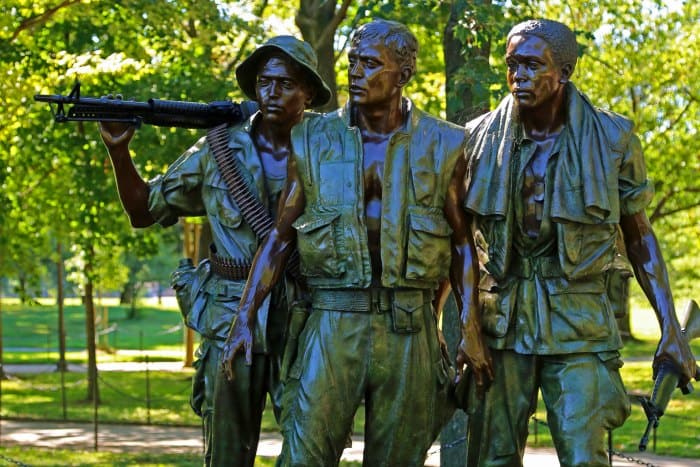
Vietnam Veterans Memorial
Top Things to do - Explore the Three Soldiers Statue, Learn about the Vietnam War, Visit Nearby Attractions like the National Mall
Lodging - There are no National Park Lodges in Washington DC.
Camping - There are no National Park campgrounds near the memorial.
Park Address - 5 Henry Bacon Drive NW, Washington 20002
The Vietnam Veterans Memorial is located on the National Mall near the Lincoln Memorial. The park is open year-round.
The "wall" portion of the Vietnam Veterans Memorial was dedicated in 1982. The wall is a 246 feet long V-shape of polished black granite displaying the names of all those who died in the Vietnam War and or who were listed as missing in action.
There is also a sculpture of three soldiers (seen in the photo above) designed by Frederik Hart.
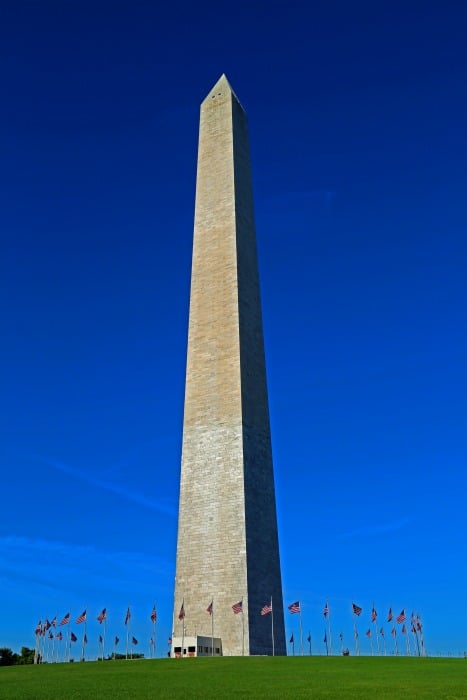
Washington Monument
Top Things to do - Explore the Monument and attend the National Cherry Blossom Festival, Join a Junior Ranger Program
Lodging - There are no lodging options within the monument
Camping - There are no National Park campgrounds in Washington DC
Park Address - 2 15th St. NW, Washington, DC 20024
The Washington Monument is located at the midpoint of the National Mall. The park recently re-opened after modernization of the elevator and construction of a permanent screening facility for visitors entering the landmark.
Construction of the Washington Monument started in 1848. Due to the Civil War and lack of funding the completion of the monument took until 1884. You can see where when construction started back in 1878 the marble was slightly darker in color.
The top ⅔ of the monument is slightly darker in color than the lower ⅓ due to the marble coming from lower down in the same quarry.
You can take an elevator to the observation level at 5oo-feet. Tickets are required for all visitors ages 2 and up.
Advance reservation tickets may be ordered at www.recreation.gov, (1.877.444.6777) 90-days in advance for a non-refundable reservation fee of $1.00 per ticket.
World War I Memorial
Top Things to do - Discover the features of the World War I Memorial, Learn about the War, read Interpretive panels along the Belvedere Wall, Check out the Medallion
Lodging - There are no lodging options within the memorial
Camping - There are no campgrounds in the World War I Memorial
Park Address - 1493 Pennsylvania Avenue NW, Washington 20004
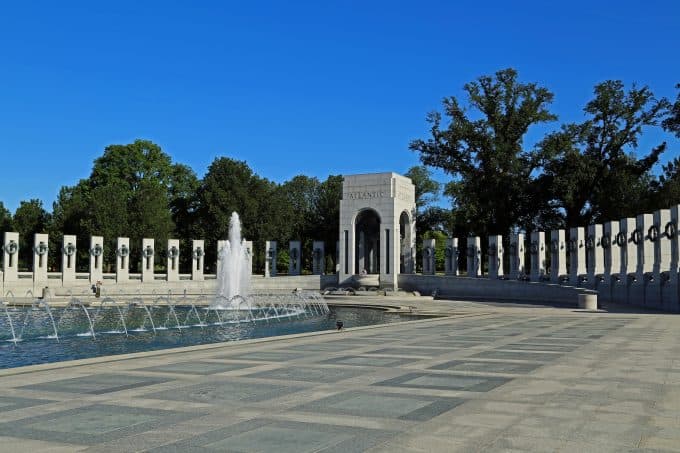
World War II Memorial
Top Things to do - Participate in Events, Walk around the Memorial, and read Inscriptions, Pay Respect, Join a Nighttime Walk with a Park Ranger
Lodging - There are no National Park Lodges in Washington DC.
Camping - There are no campgrounds within the memorial.
Park Address - 1750 Independence Ave. SW Washington 20024
The World War II Memorial is located on the National Mall between the Washington Monument and the Lincoln Memorial. The park is open year-round.
The World War II Memorial was dedicated in 2004 to honor the 16 million people who served in the United States Military along with those who supported the war effort at home.
The memorial includes a large pool and fountain, two pavilions labeled Atlantic and Pacific, a Field of Stars honoring people who passed away in the war as well as those listed as missing in action, and two semicircles of pillars denoting states and territories.
Learn more about National Park Passes for parks that have an entrance fee.
$80.00 - For the America the Beautiful/National Park Pass. The pass covers entrance fees to all US National Park Sites and over 2,000 Federal Recreation Fee Sites for an entire year and covers everyone in the car for per-vehicle sites and up to 4 adults for per-person sites.
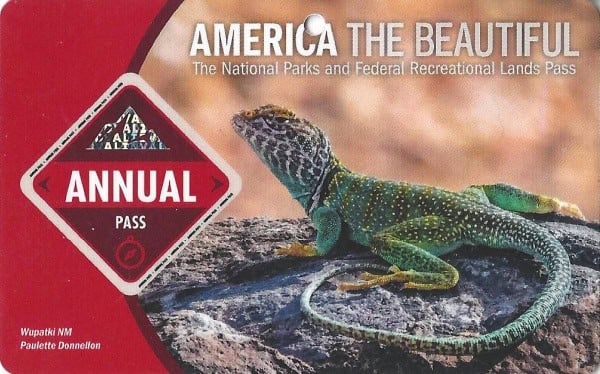
Buy your pass at this link, and REI will donate 10% of pass proceeds to the National Forest Foundation, National Park Foundation, and the U.S. Endowment for Forestry & Communities.
National Park Free Entrance Days -Mark your calendars with the five free entrance days the National Park Service offers annually.
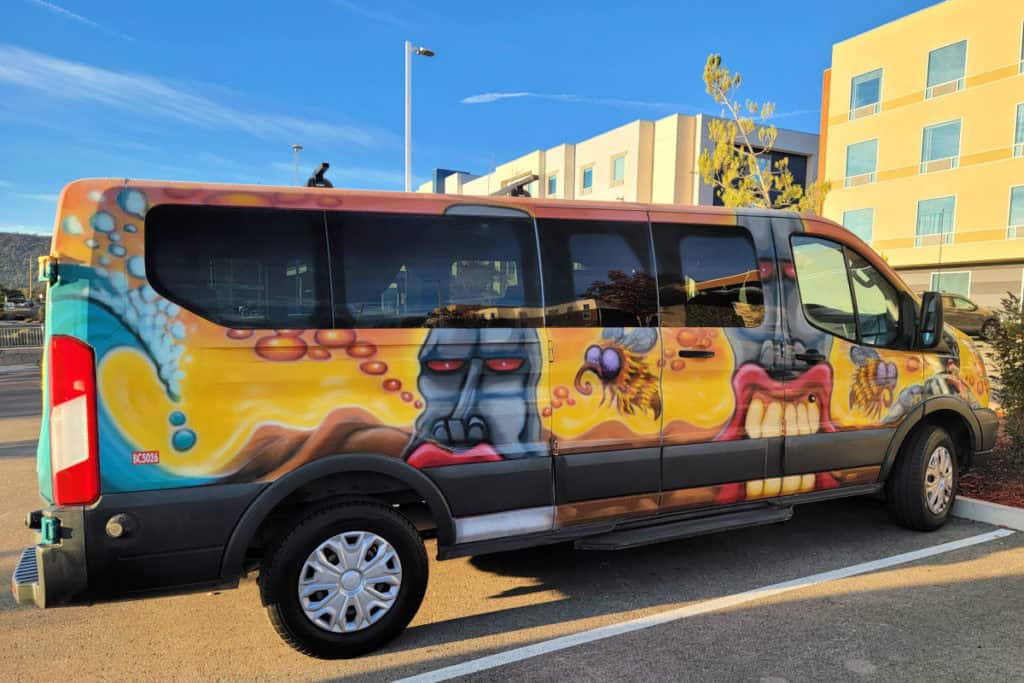
For a fun adventure check out Escape Campervans. These campervans have built in beds, kitchen area with refrigerators, and more. You can have them fully set up with kitchen supplies, bedding, and other fun extras. They are painted with epic designs you can't miss!
Escape Campervans has offices in Vancouver, Seattle, Portland, San Francisco, Las Vegas, Los Angeles, Phoenix, Salt Lake City, Denver, New York, and Orlando
List of National Parks in Washington D.C.
- Belmont-Paul Women’s Equality National Monument
- Carter G. Woodson Home National Historic Site
- Chesapeake and Ohio Canal National Historical Park
- Constitution Gardens
- Dwight D. Eisenhower Memorial
- Ford’s Theatre National Historic Site
- Franklin D. Roosevelt Memorial
- Frederick Douglass National Historic Site
- George Washington Memorial Parkway
- Korean War Veterans Memorial
- Lincoln Memorial
- Lyndon Baines Johnson Memorial Grove on the Potomac
- Martin Luther King, Jr. Memorial
- Mary McLeod Bethune Council House National Historic Site
- National Capital Parks
- National Mall
- Pennsylvania Avenue National Historic Site
- Rock Creek Park
- Theodore Roosevelt Island
- Thomas Jefferson Memorial
- Vietnam Veterans Memorial
- Washington Monument
- White House
- World War I Memorial
- World War II Memorial
If you are visiting Washington DC it is worth noting that Shenandoah National Park is only 75 miles outside of the city.
National Parks in the Neighboring States
National Parks in Pennsylvania
See our complete list of National Parks to find additional parks.
Make sure to follow Park Ranger John on Facebook, Instagram, Pinterest, and TikTok
